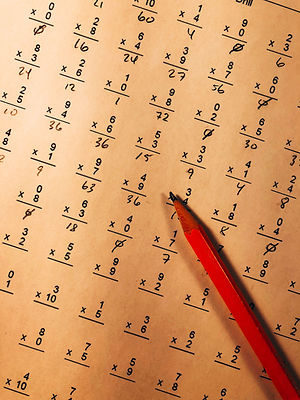
MathBait™ Multiplication
Counting by 7's
Share this resource!
In this activity students learn they can complete a skip counting table without knowing how to skip count by 7's! Introducing the idea of the commutative property, students explore how they can find multiples using various patterns and number relationships.
Details
Resource Type
Activity
Primary Topic
Dual Processing
Unit
2
Activity
7
of
13
This activity is designed for students not yet multiplying.
Provide students with an empty multiplication table and have them complete the cells they have previously learned using skip counting. Work together and announce the row or column and the strategy.
Students begin with the first row and column, counting by 1's. Then move to the second row and column counting by 2's, then to 3's, and finally to 5's. Next, remind students to skip-skip count with 2's to fill in the fourth row and column, to skip-skip count by 3's to fill in the sixth row and column, and to skip-skip count by 5's for the final column. End with filling in 8's by skip-skip-skip-skip counting and 9's by skip-skip-skip counting (2, 4, 6, 8, 10, 12, 14, 16... and 3, 6, 9, 12, 15, 18...).
Direct students' attention to their table. They might be surprised to find it is nearly filled out! Ask students what happened? We never learned to count by 7's, but our 7's are almost all filled in.

Circle back to Guess My Number and provide each student with 15 items (blocks, counting chips, candies, number blocks; any countable item will do). Ask them to organize their items into groups of 3, how many groups do they have? (5). Count the total by skip counting by 3's (3, 6, 9, 12, 15). Now ask students to organize their blocks into groups of 5, how many do they have? (3). Count the total by skip counting by 5's (5, 10, 15).
Explain that of course we have the same total! We didn't add or take away any of our blocks. Highlight that 15 items can be organized as 3 groups of 5 or as 5 groups of 3. Provide each student with 3 more blocks to now total 18. Place students in pairs and have them each organize their blocks in different ways. Have pairs discuss which they like better (for instance, a student might prefer to organize as two groups of 9 because it then requires less counting while another may prefer organizing as nine groups of 2 because they are more comfortable counting by 2's). Come together as a group to highlight the different choices and ideas. The value of 18 is great because it can be made with 1, 2, 3, 6, 9, and 18 (although one big blob of 18 isn't helpful unless we already know the total as we will need to count the items in some way).
If students need additional practice, they can try with 12 or 24 items as well.
Conclude by telling students that almost every group they can make has a "turn around". A turn around is when we swap the number of groups and how many in each group, such as two groups of 9 and nine groups of 2. See if students can identify a group without a turn around (these are our perfect squares as turning around something like four groups of 4 doesn't change anything). It isn't necessary to introduce squares at this time, only to highlight there exists numbers that can be made from equal numbers of items and groups.
Circle back to the 7's. The reason we have nearly completed the table is although we haven't decided what two groups of 7's would be, they are the same as seven groups of 2's which we already know how to count! Give students time to use the patterns on the table to try to fill in the final spot. The most common strategy is simply counting up 7 from 42.
You may practice counting by 7's aloud but at this time we don't recommend students know how to count by 7's fluently.
The material on this page is copyrighted by MathBait™. Please use and enjoy it! MathBait™ provides a temporary license for Non-Commercial purposes. You are not permitted to copy, distribute, sell, or make derivative work without written permission from MathBait™.
Tell us what you think!
Click to rate this activity

